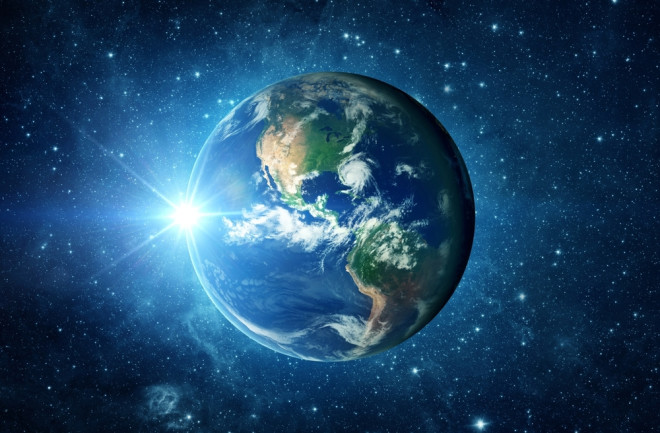Days come and go. Our circadian rhythms are tuned to the rising and setting of the Sun and the push and pull of the Moon. Days appear stable to us, an endless cycle of day and night, unless we decide to change our clocks, there are always 24 hours in a day.
However, change is the norm when it comes to Earth's day length over geological periods. Earth's satellite, our Moon, steals rotational energy to travel farther and farther away from us over time. And as the Moon's gravitational effect on the Earth diminishes, so does its ability to affect our day length.
What Controls the Length of a Day?
"It is certainly the pull of the Moon's gravity that causes the tides in the oceans to ebb and flow, and that is the dominant factor controlling Earth's day length.
There are indeed other forces that affect Earth's spin, but they generally all pale in comparison to the pull of the Moon," says Ross Mitchell, Professor at the Chinese Academy of Sciences and who recently authored The Next Supercontinent.
Mitchell was part of a team that found evidence that suggests Earth went through a billion-year period during the mid-Proterozoic (roughly 1.5 billion years ago), where days remained at a stable 19 hours long.
While lunar tidal effects on water at the Earth's surface would gradually change in the frictional force they exerted on the Earth's surface as the Moon gradually receded from Earth, another tidal force may have worked to balance out the gravitational effects of the Moon. Atmospheric tides — the heating of certain gasses in the atmosphere by the Sun –- would have pulled mass in our atmosphere towards the Sun, in a similar way the Moon pulls water towards itself on Earth's surface.
"This is where our paper enters in with the potential importance of the solar atmospheric tides. That's right, like the Moon causes tides in the oceans through its gravitational pull, the Sun causes tides in the atmosphere by heating certain gasses that readily respond like ozone and water vapor," says Mitchell.
"Much like the oceanic tide bulges in the direction of the Moon, the atmospheric tide bulges toward the Sun. But given the orbital arrangement of the 3-body system, where the Moon's tide pulls on the Earth, acting to decelerate its rotation, the solar ride actually pushes the Earth forward, accelerating its rotation.
So even though the solar tide is relatively weak today, in the past, when the pull of the Moon was weaker, it is theoretically conceivable that the two opposing forces could have balanced each other out, thus stabilizing Earth at a constant day length for some potentially long period of time," adds Mitchell.
Read More: The Moon Affected Ancient Earth In Weird Ways 2.5 Billion Years Ago
Ancient Earth's Rotation Rate
Mitchell's team gathered data from the geological record to constrain their estimates of Earth's ancient rotation rate. Early attempts to understand Earth's ancient day cycles were based on special sedimentary rocks that preserve fine-scale layering in tidal mud flats, where the tide coming in and out would leave a small layer of fine-grained silt.
You can then simply count the number of layers per month and calculate the number of hours in an ancient day. The trouble with this method is that such tidal records are rare and are disputed by geologists as being accurate.
Instead, Mitchell's team used a method called cyclostratigraphy, which uses rhythmic sedimentary layering to detect astronomical 'Milankovitch' cycles that reflect how changes in the Earth's orbit and rotation affect climate.
"Two Milankovitch cycles, precession and obliquity, are related to the wobble and tilt of Earth's rotation axis in space. The faster rotation of early Earth can therefore be detected in shorter precession and obliquity cycles in the past," says Mitchell.
"We took advantage of a recent proliferation of Milankovitch records, with over half of the data for ancient times generated in the past seven years. We realized that it was finally time to test a kind of fringe, but completely reasonable, alternative idea about Earth's paleorotation –– the intriguing but unproven theory is that day length might have stalled at a constant value in Earth's distant past," adds Mitchell.
Read More: No, the Moon Is Not Bigger on the Horizon
19 Hour Days
Mitchell describes an interesting relationship between solar tides and the evolution of Earth's atmosphere. The solar tides require gasses like water vapor and ozone to be excited, but you need oxygen to make ozone, and much of Earth's early history had very little to no oxygen.
This tells scientists that the stalling of 19-hour-long day cycles had to wait until Earth had oxygen to have ozone, and this is what they observe in the data, with the onset of the stalling of Earth's day length occurring after the Great Oxygenation Event some 2.4 billion years ago.
It took a second large oxygenation event, occurring 800 million years ago, to break the stalled 19-hour-long day, and Earth's day returned to its gradual slowing down.
"Since oxygen is created by photosynthetic bacteria, it's very possible that the second large increase in atmospheric oxygen had to wait for longer days and thus more sunlight in order to create enough oxygen in a day for it to meaningfully accumulate in the atmosphere," says Mitchell.
Read More: How the Maya Created Their Extraordinarily Accurate Calendar Thousands of Years Ago

